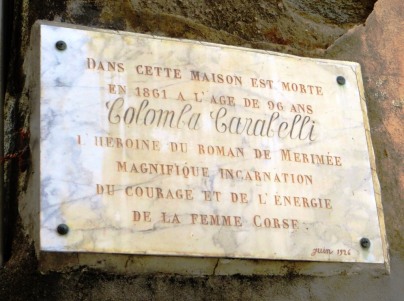
We’ve visited Corsica six times. L’Île de Beauté is a captivating place, with a savage beauty and a culture all its own and I strongly advise a visit. In 2014, we went to Olmeto, once the home of a woman who was the inspiration for Prosper Mérimée’s Colomba. His novel is about vendetta, an integral feature of Corsican history and culture.
Vendetta, honour and revenge
Corsica has been under foreign rule for most of its history. It’s been part of France only since 1768. The themes of honour, murder and revenge run like a bloody fault line through the island’s past. In the absence of a regular or consistent justice system, the Corsicans developed their own method of dispute resolution: the vendetta.
The Corsican code of honour demanded that the men of the family had to repay insults and murders in blood. Causes of vendetta could be as serious as a killing or as trivial as a goat straying into someone else’s vegetable patch. Since the rival family reciprocated, the result was a vicious spiral of violence and murder that often continued for generations.
The family kept the blood-stained shirt of the vendetta victim until they had avenged his death. Meanwhile, the men abstained from cutting their hair or shaving until they had taken revenge.
Major cause of death
Vendetta incidents reached a peak during the 18th century. Up to 900 people per year were murdered out of a total population of little more than 100,000. The leader of the island’s short-lived republic, Pascal Paoli, tried to stamp out the practice but was only partially successful.
During the 19th century, one vendetta even threatened to degenerate into civil war, but 100 feuding families were persuaded to sign a peace treaty in 1879. The last recorded vendetta incident took place in 1954 after rival families swapped insults at a funeral and started a brawl in which several people were killed.
Olmeto and Colomba Carabelli

It’s not hard to see how warring factions might have developed in the mountain villages. Few of them have a proper centre: they are often built down the side of a hill, with steep lanes or staircases connecting the quartiers. The austere granite houses, with their small windows and lack of ornament, are almost like fortresses.
Olmeto in the southwest of the island is no exception. This atmospheric town is now somewhat marred by a main road slicing through it. But you soon leave that behind if you go up or down the terraced levels.
Colomba Carabelli lived in a house opposite the church and died aged 96 (or 86 according to some accounts) in 1861. She had moved to Olmeto from Fozzano, where Prosper Mérimée met her.
Colomba’s family was involved in a particularly bloody vendetta at Fozzano, in which her son was killed. Hearing shots in the valley, she assumed that her son’s ambush of their enemies had been successful. She shouted to a member of the opposing family:
“There’s fresh meat for you down there.”
Knowing that her son was also dead, he replied, “And for you, too!”
Vendetta in literature
Prosper Mérimée fictionalised her story. The heroine of Colomba is young and beautiful but bloodthirsty and formidable. Following the murder of her father, she tries to incite her reluctant brother, recently returned from the Napoleonic Wars, to avenge his death.
Colomba is also a voceratrice, who improvised mourning songs at funerals. She uses the death of a neighbour to stir up the menfolk with her song calling for revenge.
Balzac (La Vendetta) and Dumas (Les Frères Corses) also wrote about vendetta. Both novels dealt with the theme of expatriate Corsicans who were unable to escape from the cultural traditions of their homeland.
The stuff of novels?
Given this powerful topic, I’m surprised that more writers in English have not chosen to write novels about it. The House at Zaronza, mentions vendetta but, since it is based in early 20th-century Corsica, the practice was no longer so common. However, inspired by Mérimée’s description, I did include a voceratrice at a funeral. The strong Corsican concept of family honour is also an integral part of my book.
Dorothy Carrington’s authoritative Granite Island: A Portrait of Corsica includes a thoughtful and erudite account of vendetta and its history. Today, vendetta is seen as a picturesque illustration of a troubled past and it’s easy to make a cliché of it in fictional accounts. But it demonstrates the deep and lasting conflicts in Corsican society.
You might also like:
Why Corsica Should be a Happy Hunting Ground for Authors
Ten Inspiring Things About Corsica Part 1
Ten Inspiring Things About Corsica Part 2
Copyright © Vanessa Couchman 2016, all rights reserved
Reblogged this on Crooked Cats' Cradle.
LikeLike